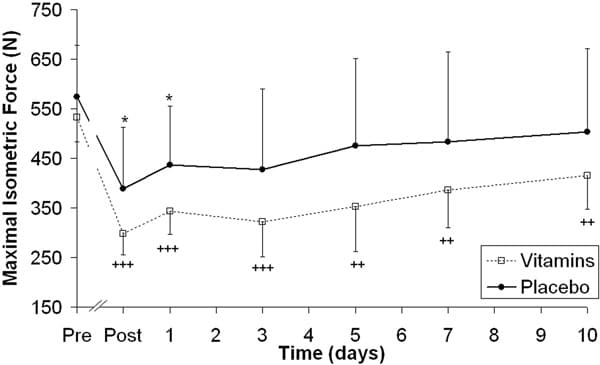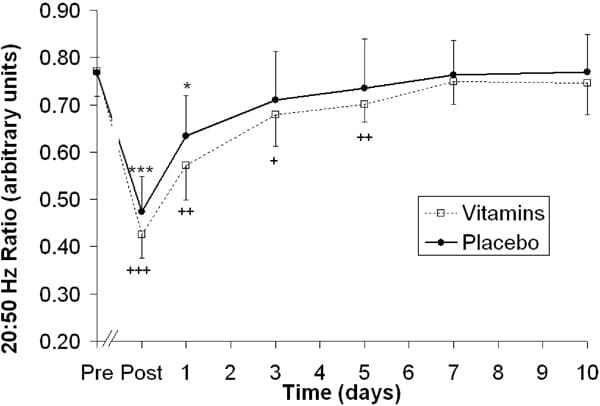Reactive oxygen species production has been implicated in exercise-induced muscle damage following eccentric exercise. Studies on the protective effects of dietary antioxidant supplementation (AS) on muscle damage have been equivocal. However, there is some evidence that AS may attenuate indices of muscle damage (Jakeman et al., 1993; Shafat et al., 2004). The aim of the current study was to investigate the effect of pre- and post-supplementation with vitamins C and E on symptoms of eccentric muscle damage in males. An AS regimen was designed to maximise the antioxidant content of the exercising muscles. The study employed a randomised, double-blind, placebo-controlled, cross-over design. Six males (24±4 years, 175.8±8.3 cm, 74.0±6.4 kg, mean±S.D.) were randomly allocated into two groups, vitamin supplementation (V) or placebo (P). The V group received 2×500 mg of vitamin C and 2×600 IU of α-tocopherol daily and the P group received similar tablets for 38 days (28 days pre-, 10 days post-exercise). On day 29 volunteers performed 150 maximal eccentric contractions of the knee extensors (50 sets of 3 at one minute intervals) using a randomly selected leg at a velocity of 0.52 rad.s-1, while lying prone on an isokinetic dynamometer. Seated maximal voluntary isometric contraction force (at 90° knee angle) and electrically evoked force at a frequency of 20 Hz and 50 Hz were recorded before and immediately after exercise, and on days 1, 3, 5, 7 and 10 post-exercise. On the same occasions and on day two, muscle soreness was recorded for the quadriceps muscle group using self palpation at 6 points, with results recorded on a ten-point soreness scale. After a 69-day washout period the subjects received the alternate supplement for 38 days, performing the eccentric exercise protocol on the contralateral leg. Maximal voluntary isometric force (Fig. 1) and 20:50 Hz force ratio (Fig. 2) decreased significantly in both groups (P<0.001, RM-ANOVA; post-hoc analysis of means and confidence intervals), with no difference seen between treatments. Muscle soreness increased significantly (P<0.01, RM-ANOVA) peaking on day 2 following both treatments, and gradually returning to baseline by day 10. These results suggest that prophylactic supplementation with vitamins C and E does not ameliorate the functional deficit caused by eccentric exercise in men.
Life Sciences 2007 (2007) Proc Life Sciences, C65
Research Symposium: Pre-supplementation with vitamins C and E does not reduce indices of exercise-induced muscle damage in men
C. McGinley1, A. Shafat1, B. Ward1, N. Briganti1, A. E. Donnelly1
1. Physical Education and Sports Sciences, University of Limerick, Limerick, Ireland.
View other abstracts by:
Figure 1. Mean ± S.D. of maximal isometric force after eccentric exercise. +++ P<0.001 ++ P<0.01 compared to pre-test for V (n=6). * P<0.05 compared to pre-test for P (n=6).
Figure 2. Mean ± S.D. of 20:50 Hz ratio after eccentric exercise. +++ P<0.001 ++ P<0.01 + P<0.05 compared to pre-test for V (n=6). *** P<0.001 * P<0.05 compared to pre-test for P (n=6).
Where applicable, experiments conform with Society ethical requirements.


